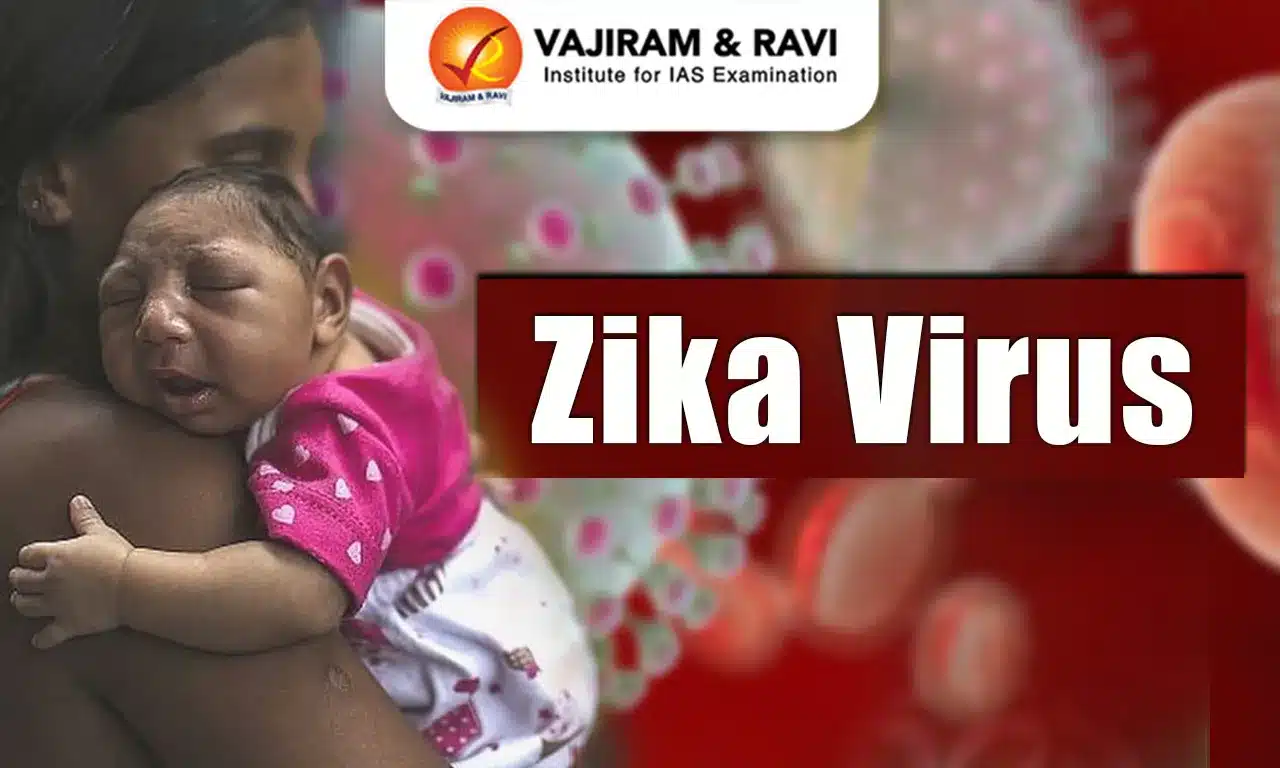Zika is a mosquito-borne virus, first identified in Uganda in 1947 in a Rhesus macaque followed by evidence of infection and disease in humans and other African countries in the 1950s. The infection itself (sometimes called Zika fever) is usually mild and goes away on its own. However, the impact of the virus has most significantly been seen in pregnant women and their fetuses. Zika virus infection is associated with microcephaly in newborns, which means their head is smaller than normal. It can also cause Guillain-Barré syndrome, a rare nerve disorder that causes muscle weakness and paralysis.
About the Zika Virus
Zika virus disease is caused by a virus from the Flavivirus genus, Flaviviridae family.Zika is mostly transmitted through the bite of an infected Aedes species mosquito (Aedes aegypti and Aedes albopictus) which acts as vectors for dengue and yellow fever as well.
- Zika virus infection can cause microcephaly in newborns, which means their head is smaller than normal. It can also cause Guillain-Barré syndrome, a rare nerve disorder that causes muscle weakness and paralysis.
- The Zika virus was named after the Zika Forest in Uganda, where it had been discovered for the first time in 1947 and the first human case of Zika was reported in 1952.
- The Zika virus caused a significant epidemic in Brazil in 2015.
- In 2016 WHO declared the Zika virus, various neurological illnesses, and microcephaly as Public Health Emergency of International Concern (PHEIC).
- Spread in India: Zika virus cases have been detected in the states of Gujarat, Madhya Pradesh, and Rajasthan in 2018 and Kerala, Maharashtra in 2021. However, Zika virus-associated microcephaly was not recorded.
Structure
Zika virus is a single-stranded RNA virus belonging to the Flaviviridae family. The Asian and African lineages are the two major geographically distinct lineages of the virus.
- The African lineage affects monkeys and apes as primary hosts and humans as secondary hosts, whereas the Asian lineage affects humans as primary hosts.
- The Zika virus is a single-strand ribonucleic acid (RNA) virus and the RNA is translated into a single polyprotein that encodes three structural proteins—capsid (C), membrane (M), and envelope (E)—as well as seven nonstructural proteins.
- The viral particle is formed by structural proteins, as the name implies.
- Nonstructural proteins aid in genome replication and packaging, as well as manipulating host processes in favour of the virus.
- For the first time, cryo-electron microscopy was utilised to reveal the near-atomic structure of the Zika virus.

Transmission Modes
Zika virus is primarily transmitted to humans by the bite of an infected Aedes aegypti mosquito. Other ways of viral propagation include:
- Through sexual contact with the sick person
- Transfusions of blood and organ transplantation
- Congenital infection from mother to foetus because the virus is capable of crossing the placental barrier.
- Testing: Zika virus disease diagnostics is primarily based on the detection of viral RNA from clinical specimens (blood, saliva, urine, cerebrospinal fluid, amniotic fluid, semen, and breast milk).
Symptoms
The incubation period is usually between three to twelve days after being bitten by an infected mosquito. Approximately 80% of the infections are asymptomatic.
- The most common symptoms are a maculopapular rash (+/-itchy), arthralgia, fatigue, non-purulent conjunctivitis/conjunctival hyperaemia, myalgia, and headache.
- The maculopapular rash frequently begins on the face and spreads across the body. Retro-orbital pain and gastrointestinal symptoms are less common.
Treatment
There is no vaccination or preventative treatment available.
- The treatment is symptomatic and mostly focuses on hydration, pain alleviation, and antihistamines for pruritic rash.
- The key to controlling the spread of the Zika virus is to have a comprehensive approach that includes regular vector surveillance and integrated vector management of Aedes mosquitos.
- Environmental modification/manipulation, personal protection through protective clothing and repellents, biological control using larvivorous fish and bacillus thuringiensis, and chemical control using larvicides(temephos) and adulticides (pyrethrum, malathion), are all part of integrated vector management.
Challenges
The challenges in India’s Zika virus management are listed below:
- Limited knowledge: concerning the virus's epidemiological properties and its interactions with other arboviruses, such as dengue.
- Limited lab capacity and cross-reactivity of diagnostic flavivirus antibody assays.
- Absence of Herd immunity: In freshly affected countries. High population mobility and cross-border movement of infected travellers also act as significant challenges.
- No vaccinations or antiviral treatments are available: for microcephaly and other birth defects in babies, as well as cases of Guillain-Barre syndrome and other neurological diseases.
- Other factors: Favourable breeding conditions for Aedes mosquitos. Inadequate vector surveillance system. Underfunding and inadequate facilities in India's healthcare system result in ineffective epidemic control response.
Last updated on January, 2026
→ Check out the latest UPSC Syllabus 2026 here.
→ Join Vajiram & Ravi’s Interview Guidance Programme for expert help to crack your final UPSC stage.
→ UPSC Mains Result 2025 is now out.
→ UPSC Notification 2026 is scheduled to be released on January 14, 2026.
→ UPSC Calendar 2026 is released on 15th May, 2025.
→ UPSC Prelims 2026 will be conducted on 24th May, 2026 & UPSC Mains 2026 will be conducted on 21st August 2026.
→ The UPSC Selection Process is of 3 stages-Prelims, Mains and Interview.
→ UPSC Result 2024 is released with latest UPSC Marksheet 2024. Check Now!
→ UPSC Toppers List 2024 is released now. Shakti Dubey is UPSC AIR 1 2024 Topper.
→ Also check Best IAS Coaching in Delhi
Zika virus FAQs
Q1. Which disease is caused by Zika virus?+
Q2. How is Zika virus transmitted?+
Q3. Can the Zika virus be transmitted through Breast milk?+
Q4. What is Microcephaly?+
Tags: quest zika virus

















